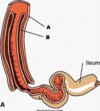Alimentary System Flashcards
(273 cards)
What is the predominant disease of dogs and cats?
Neoplasia
What is the predominant disease of horses?
Colic
Normal oral or gastrointestinal mucosa should be?
Smooth and shiny
T/F feces can be a window into the health of the alimentary tract?
True
List four portals of Entry.
Ingestion, coughed up and swallowed, hematogenous, migration through the body.
What is the most common portal of entry?
Ingestion
What pathogen is commonly coughed up and swallowed?
Rhodococcus equi
What is a common parasite that migrates through the body?
Spirocerca lupi
What defense mechanisms does the alimentary tract have?
Saliva, flora, gastric pH, Igs, vomiting, enzymes, phagocytes, high epithelial turnover, increased peristalsis (diarrhea)
What species commonly gets cleft palate?
Bovine (calves)
What are the causes of cleft palate?
Genetics, toxins, teratogenic plants (lupines, poison hemlock), materinal exposure to drugs (mares and queens: griseofulvin, primates: steroids)
What is cleft palate?
Defect in the midline fusion of the palatine shelves.
What is the most common complication of cleft palate?
Aspiration pneumonia
What is a common complication with malocclusions?
Difficulties with prehension and mastication
What is this called?

Cheiloschisis or harelip
What is cheiloschisis?
Harelip
What is brachygnathia?
Shorter lower jaw (overbite).
What is prognathia?
Protrustion of the lower jaw (underbite).
Name the layers of the crown of the tooth.
Enamel, dentin, pulp.
Name the layers of the root of the tooth.
Cementum, dentin, pulp.
What is dental atrition?
Loss of tooth structure due to mastication/chewing.
“Step mouth is most common in…?
Herbivores
What is dental plague?
Bacterial film
What is dental calculus?
Mineralized dental plaque.






































